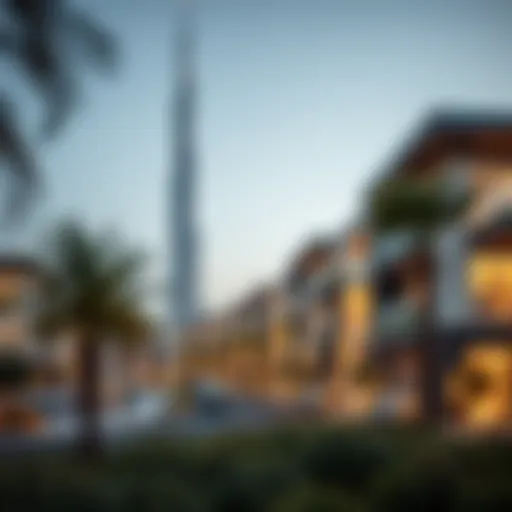Burj Binghatti: Features and Completion Date Insights
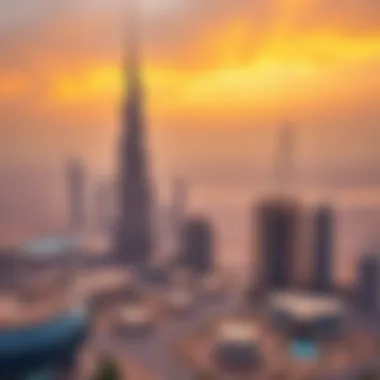

Intro
The Burj Binghatti stands to redefine the iconic skyline of Dubai, adding yet another hallmark to the city’s diverse architectural portfolio. This towering structure is much more than a mere point of interest; it embodies the convergence of bold design and innovative construction principles. Its significance transcends aesthetics, facilitating a deeper understanding of current real estate dynamics and future opportunities in one of the world’s most lucrative property markets.
As Dubai continually morphs into a global center for commerce and tourism, the Burj Binghatti is a clear manifestation of the ambition that drives this vibrant metropolis. Interested parties—from seasoned investors to novice expatriates—are keenly watching the completion date of this skyscraper as it holds implications for overall property values and urban development trends in the surrounding area.
Delving into how Burj Binghatti fits into the larger narrative of Dubai’s growth will shed light on the ongoing shifts in the city's property sector, revealing paths for investment and growth in high-demand areas.
Overview of Burj Binghatti
The Burj Binghatti, rising majestically on the Dubai skyline, represents a beacon of contemporary architecture and innovation. This tower is not just another skyscraper; it's a testament to human ingenuity, where design meets luxury and functionality. As we dissect its many facets, from its conception to its architectural marvels, we gain a deeper understanding of why the Burj Binghatti is pivotal to Dubai's ever-shifting real estate narrative.
Genesis of the Project
The roots of the Burj Binghatti can be traced back to an ambition: to create a landmark that echoed Dubai’s rapid development and dreams of grandeur. Initiated by Binghatti Developers, this project is a reflection of Dubai's relentless pursuit of architectural excellence. The plan set forth by the developers was clear—the intention was to infuse the essence of mixed-use living into a single towering structure, which could accommodate luxury residences, hospitality suites, and commercial spaces under one roof. This ambitious vision was not merely about height but aimed to provide a community feel in a bustling metropolis where such concepts often get overshadowed by the urgency of urban life.
Architectural Significance
A deep dive into the architectural underpinnings of the Burj Binghatti showcases its distinct character, marking it as a highlight of modern engineering. With a planned height that exceeds many adjacent structures, this skyscraper is designed not just to stand tall but to captivate. Its sharp angles and intricate facades are harmonized to mirror the surrounding landscape while also standing out as a symbol of opulence. The innovative approach to using lightweight, sustainable materials stands out as a hallmark of responsible construction practices.
"The Burj Binghatti is not just built to impress; it is sculpted to resonate with the dreams of those who inhabit it."
Moreover, the building incorporates advanced technologies to ensure structural integrity and functionality. From high-speed elevators running in sync with its towering heights to smart home systems in each unit, the design accommodates future residents' every need, aiming to redefine upscale living in one of the world's most iconic cities. Investors, brokers, and prospective buyers seeking to understand the essence of luxury will find the architectural features of Burj Binghatti offer a nuanced look into tomorrow’s real estate market, where design does not compromise comfort.
In this section, we have laid the groundwork for what’s to come. We’ll delve deeper into the current status and what the anticipated completion of the Burj Binghatti means for Dubai and the global architectural landscape.
Current Status and Completion Timeline
Understanding the current status and completion timeline of the Burj Binghatti is crucial for various stakeholders, including investors, brokers, expatriates, buyers, and researchers. This information not only highlights the progress of one of Dubai's most ambitious skyscrapers but also illuminates how it will affect the broader real estate market. Keeping an eye on construction milestones and anticipated delivery dates can help potential buyers make informed decisions and allow investors to assess the project's viability.
Current Construction Progress
As of now, the construction of Burj Binghatti is underway and making headway. Reports indicate that the building's core structure has reached substantial height, which is quite the feat in such a competitive skyline. Several key milestones have been achieved since the project broke ground:
- Completion of foundational work: The groundwork set a solid base, essential for a structure designed to touch the clouds.
- Rising framework: The skeleton of the building has been gradually going up, and the use of innovative construction materials has been a game-changer.
- Advanced engineering methods: These methods enable quicker assembly while maintaining safety and integrity, bringing us closer to seeing the final product.
Investors are keeping a sharp eye on these developments, as every completed floor is more than just a step toward completion; it’s a signal of rising property values in the surrounding area. Given that the Burj Binghatti is poised to be the tallest residential building globally, its structural evolution garners excitement from both locals and interested investors alike.
Setting a Completion Date
The setting of a completion date for Burj Binghatti is perhaps one of the most anticipated announcements in Dubai’s real estate agenda. While an official date has yet to be shared, industry insiders speculate a timeline that hints at a finish within the next couple of years. Key considerations affecting this timeline include:
- Seasonal weather conditions: The extreme heat during summer months sometimes slows down construction processes.
- Supply chain dynamics: While there has been progress, delays in acquiring materials can impact the timeline significantly.
- Regulatory approvals and inspections: Each step must meet stringent safety and architectural standards, which can introduce unexpected delays.
"Timelines are subject to change, but the ongoing progress assures that Burj Binghatti is set to rise brightly in the Dubai skyline."
As the anticipated completion date draws nearer, buyers and investors will be keen to weigh their options. Understanding when the building will be ready not only aids in personal investment planning but also stirs interest in the surrounding properties, leading to a ripple effect in the wider real estate market. Keeping abreast of updates will aid in navigating the opportunities that the Burj Binghatti will bring.
Impact on the Real Estate Market
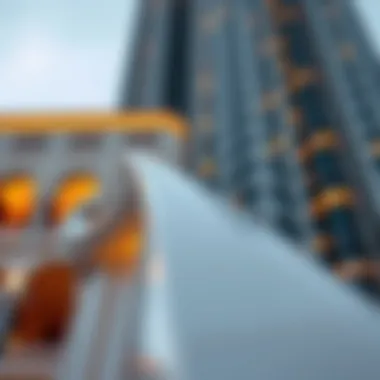
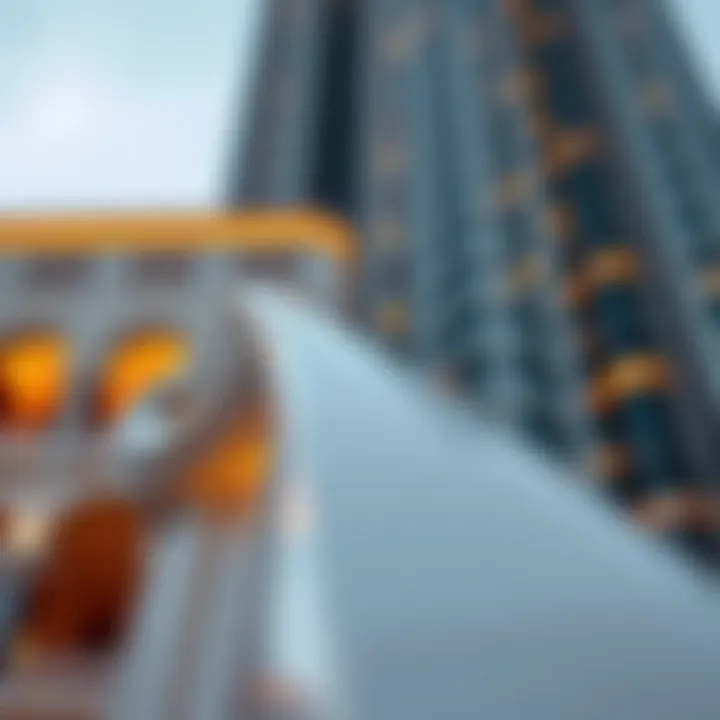
The Burj Binghatti is poised to significantly influence Dubai's real estate landscape. As this iconic skyscraper rises, it doesn't merely add to the skyline; it transforms the market dynamics. For investors, brokers, expatriates, and potential buyers, understanding the implications of this skyscraper is paramount. The Burj Binghatti is a beacon that signals new opportunities and shifts within the market. Its architectural innovation and luxurious features could carve out a new niche, potentially attracting a wealthier clientele and reshaping property values in the vicinity.
Market Trends Post-Completion
The completion of Burj Binghatti will likely trigger substantial shifts in market trends. Investors should pay attention to:
- Price Appreciation: With high-profile developments, property values tend to soar. Historical data indicates that once luxury towers like Burj Binghatti open, surrounding properties generally see a spike in market prices.
- Demand Surge: Luxury residences often attract not only local buyers but also international investors. The allure of prestigious living in proximity to such an architectural marvel boosts demand for all property types in the area.
- Changing Buyer Preferences: The rise of the Burj Binghatti could influence buyer trends towards high-rise living, especially among expatriates and young professionals seeking urban lifestyles.
With these trends, stakeholders should keep a close eye on shifting buyer demographics and the kind of amenities people prioritize as the city evolves.
Investment Opportunities
Burj Binghatti opens a door to numerous investment opportunities for savvy investors and developers alike. Key factors include:
- Prime Location: Situated in a central area of Dubai, providing high visibility and accessibility. This choice puts potential rental and resale properties in a prime light, making them lucrative investments.
- Luxury Market Growth: With the continuous growth in the luxury segment, investing in a property that complements high-end living can yield significant returns. Developers can focus on enhancing their offerings by integrating luxury amenities tailored to affluent clientele.
- Tourism Potential: Dubai is a tourism hotspot, and properties near landmark attractions perform well in the short-term rental market. The Burj Binghatti's stature can assist in promoting surrounding properties to tourists.
- Commercial Developments: Beyond residential investments, the area may attract businesses seeking high-profile office spaces, given the skyscraper's significant standing. Thoughtful investments in commercial sectors could yield profitable returns.
"The skyline that Burj Binghatti introduces is not just about aesthetics; it’s a new chapter in Dubai's architectural and economic narrative."
For more insights, you can reference resources from Wikipedia or Britannica.
Understanding these elements will enable all stakeholders to make informed, strategic decisions in the fast-paced world of Dubai real estate.
Design and Features of Burj Binghatti
The design and features of the Burj Binghatti are pivotal elements that capture the essence of advanced architecture blended with vibrant luxury. This towering structure, aiming to redefine the skyline of Dubai, isn't merely a functional building; it's a symbol of innovation, luxury, and sustainability. With each facet reflecting strategic planning and artistic design, Burj Binghatti sits at the intersection of modern living and aesthetic allure, which offers significant benefits to both its residents and the broader community.
Height and Dimensions
Standing at a staggering height, the Burj Binghatti is designed to take its place among the tallest buildings in the world. Rumored to reach approximately 1000 meters, the towering presence of this skyscraper aims not only to offer breathtaking views but also to create a sense of grandeur that can only be admired from its upper echelons. The overall dimensions have been meticulously crafted to maximize space while ensuring stability and resilience against environmental factors.
Furthermore, the building’s height is not just about reaching for the skies; it symbolizes the ambitious spirit of Dubai, mirroring the aspirations of those who flock to this dynamic city. To put it simply, it stands as a testament to what can be achieved through audacious designs and engineering excellence.
Luxurious Amenities
The appeal of Burj Binghatti extends far beyond its height. Inside, residents and visitors will soon discover luxurious amenities that redefine the concept of upscale living. Sky lounges, infinity pools, and private gardens are just a few of the features expected in this opulent setting.
- Exclusive Fitness Centers: State-of-the-art gyms and wellness facilities promote a healthy lifestyle, ideal for the high-achieving individuals of Dubai.
- Gourmet Dining: Luxurious restaurants with views that make every meal an occasion to remember.
- Concierge Services: Round-the-clock personal assistance that enhances the living experience, making daily tasks effortless and convenient.
This amalgamation of amenities not only supports a lavish lifestyle but also fosters a sense of community among residents, creating spaces where they can connect and network. The amenities are designed to cater to those who understand that luxury is not just a statius symbol; it’s a way of life.
Innovative Engineering Solutions
To ensure the Burj Binghatti stands resilient against the harsh climate of the Middle East, innovative engineering solutions have been integral in its design and construction. Computational modeling and advanced materials have been employed to enhance strength and durability. This skyscraper incorporates a unique façade that minimizes heat absorption, thus reducing energy consumption.
Incorporating features like wind turbines and rainwater harvesting systems reflects a commitment to sustainability, a growing priority in modern architecture. The blend of cutting-edge technology with environmentally-conscious features positions Burj Binghatti as a leader in responsible design.
"As skyscrapers evolve, so must our approach to their design and utilization for a sustainable future."
Community and Environmental Considerations
The Burj Binghatti isn't just another skyscraper in Dubai's sprawling skyline; it aspires to be a beacon of community and environmental awareness. As the project progresses, the considerations for both the local populace and ecology become increasingly significant. In keeping with the ambitions of sustainable urban development, the integration of community-friendly designs and green practices can profoundly impact how people perceive and utilize the space.
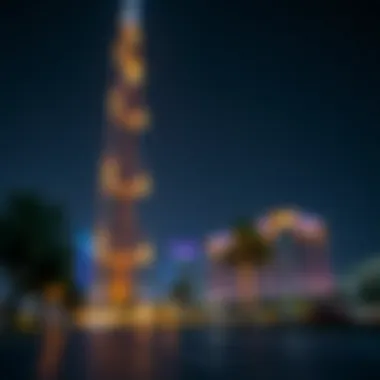
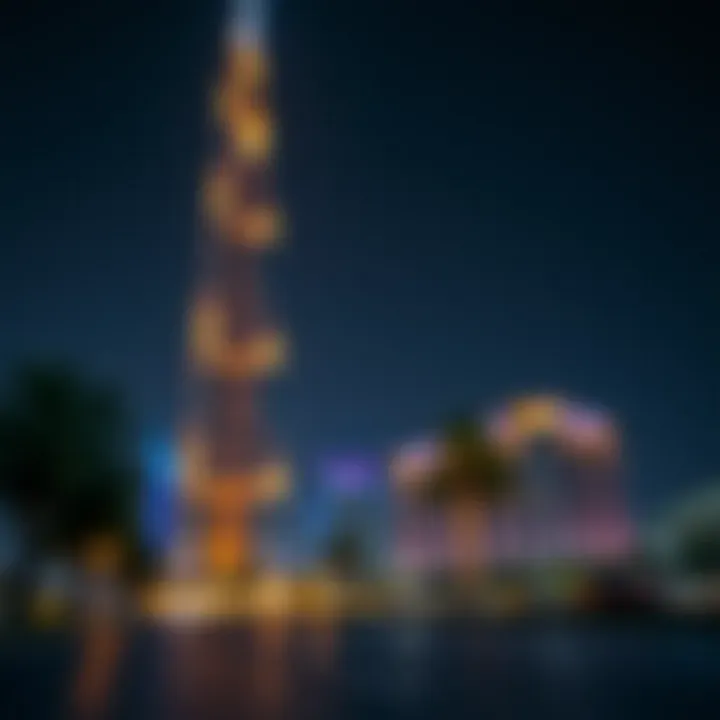
Community Integration
Integrating the Burj Binghatti with its surrounding community is essential for creating a space that feels welcoming rather than isolated. The design team has emphasized the importance of public spaces and amenities that serve the local residents and visitors alike. This involves creating not only luxury apartments and commercial areas but also open parks, community centers, and spaces for social gatherings. The goal is to transform the immediate vicinity into a vibrant area where cultures can collide, and community engagement flourishes.
- Community Programs: Plans are in place for various community-driven programs, such as workshops and cultural events that celebrate local traditions while bringing residents together.
- Located Facilities: Facilities like galleries, farmer's markets, and recreational areas will ensure that the Burj Binghatti serves the wider real estate market, promoting engagement rather than alienation.
On a more informal level, the presence of various cafes and shops will cater to people looking for leisure, igniting a buzz that can lead to sustainable economic activities in the surrounding areas. Locations like this can become melting pots of ideas and diversity, essential for fostering a sense of belonging.
Sustainability Features
Amidst the glimmer of its glass facade, Burj Binghatti aims to be a model of sustainability, embodying practices that not only minimize the environmental impact but also contribute positively to the community. The skyscraper incorporates various features designed to meet the pressing environmental challenges of our time.
- Energy Efficiency: Advanced building technologies are being utilized. For instance, energy-efficient windows reduce heat gain and reliance on air conditioning.
- Water Conservation: Rainwater harvesting systems will be installed to help reduce water wastage. This reduces the strain on existing water resources while reclaiming rainwater for irrigation.
- Green Spaces: Vertical gardens and terrace plantings aim to bring a breath of fresh air into the concrete-laden environment.
"A building that harmonizes with nature will not only save resources but enrich lives."
Implementing these features not only reaffirms Dubai's commitment to sustainability but also reflects a growing trend among investors and residents alike who prioritize concepts of eco-friendliness. As future buyers and expatriates evaluate real estate options, developments like Burj Binghatti, which embrace sustainability, will undoubtedly rise to the top of their lists.
In summary, the Burj Binghatti stands as a testament to thoughtful community integration and robust environmental features; it symbolizes a shift towards mindful urban development, promising not just a new height in the cityscape, but also a significant leap towards sustainable living.
Challenges Encountered During Construction
The construction of the Burj Binghatti is not just a monumental architectural endeavor; it represents a series of complex challenges that the builders had to navigate. Understanding these challenges offers insight into the resilience of urban development and the innovative mindsets required to push the boundaries of engineering and design.
Technical Challenges
Building a skyscraper of this magnitude often brings a host of technical problems, and Burj Binghatti is no exception. One of the primary issues has been integrating cutting-edge technologies with traditional construction methods. For instance, the structural system must support the height and design elements without compromising safety or aesthetic appeal.
To achieve this balance, engineers have had to fine-tune the materials and construction techniques they employed. They opted for high-strength concrete, which can handle the immense loads while minimizing material volume. This choice, however, comes with its own challenges, such as requiring careful handling and an optimized curing process to prevent cracking during the initial phases of construction.
Additionally, the site's proximity to existing structures posed unique difficulties. Heavy machinery needed careful maneuvering, and vibration control measures were crucial to avoid damaging surrounding buildings. That's a lot of juggling, and it often felt like balancing on a tightrope while blindfolded.
Regulatory Hurdles
Navigating the legal landscape presents another layer of complexity in the construction process. Regulatory requirements can feel like a maze, especially in a city as dynamic as Dubai. From obtaining proper zoning approvals to meeting environmental assessments, bureaucracy can slow down the momentum of even the most well-planned projects.
In particular, the Burj Binghatti faced stringent regulations regarding height restrictions and land use, which necessitated extensive planning and consultations with local authorities. The builders had to ensure that their plans aligned with Dubai’s vision for sustainable urban development, which can change like the wind.
Furthermore, compliance with safety standards is non-negotiable. The building's safety systems, including fire safety and emergency evacuation strategies, must adhere to international standards despite the unique challenges posed by its height and design.
"Construction isn't just about bricks and mortar; it's about negotiating with rules and realities that often shift without warning."
Comparative Analysis with Other Skyscrapers
When discussing the Burj Binghatti, it's vital to place it within the broader context of skyscrapers, especially those that have shaped Dubai's stunning skyline. The analysis of surrounding and comparable structures provides a roadmap for understanding the Burj Binghatti's architectural and economic significance. It sheds light on the current trends and what Burj Binghatti might mean for the future of urban architecture in the UAE.
Notable Nearby Developments
Burj Binghatti is not being built in isolation. It shares its landscape with some of the most iconic structures in the world. Consider the Burj Khalifa, the tallest building in the world, holding a record that will not be easily toppled. Additionally, the Dubai Marina, known for its stunning waterfront views and luxurious lifestyle, is just a stone's throw away.
Some notable nearby developments include:
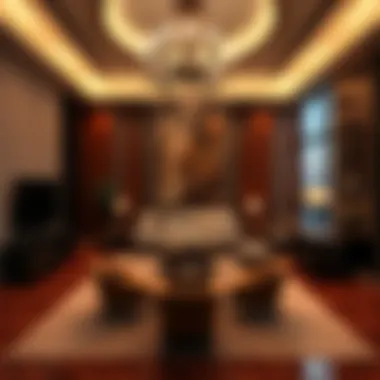
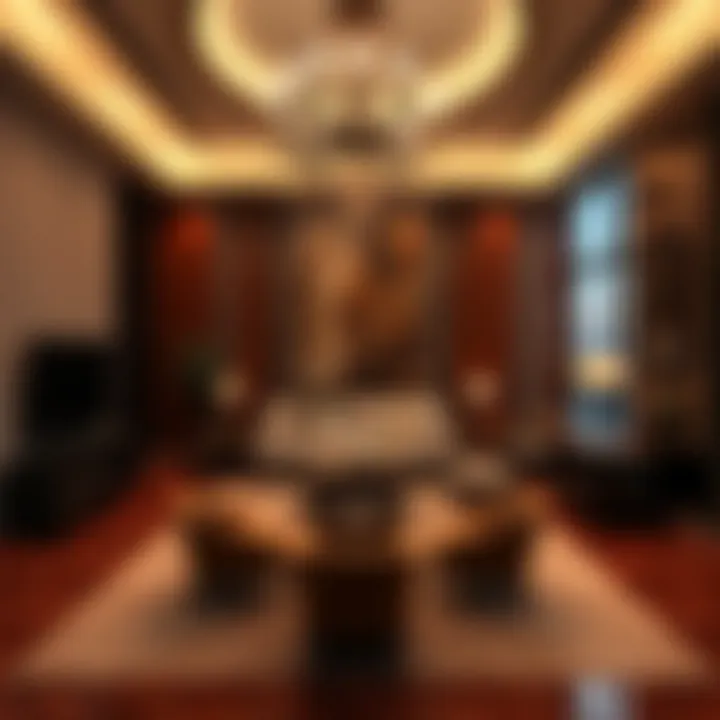
- Marasi Riverside: A unique lakefront living experience with high-end residential units, providing a different flavor of luxury mixed with natural beauty.
- One Za'abeel: Known for its 'The View', this development is poised to make its mark as one of the tallest buildings, capturing attention with its innovative engineering.
- Royal Atlantis Resort & Residences: Famed for its luxury and leisure aspects, this place attracts affluent buyers and investors alike.
Looking at these projects side by side with Burj Binghatti helps in understanding the competition and collaboration in design, aesthetics, and market value. Each of these establishments has set a high bar, and Burj Binghatti is positioned to contribute to this prestigious portfolio, possibly attracting similar high-caliber investors and residents.
International Comparisons
Broadening our scope, it makes sense to review how Burj Binghatti stands alongside global architectural marvels. Think about the Shanghai Tower and the Abraj Al Bait in Mecca; these are not just tall structures but represent the essence of ambitious engineering paired with cultural significance.
International comparisons bring a wealth of insight:
- Shanghai Tower: At 632 meters, it embraces sustainability in a brewing metropolis and is equipped with energy-efficient systems that reduce its environmental impact.
- Abraj Al Bait: Known for its historical resonance, this complex comprises hotels and residential spaces, embodying a unique blend of modern technology and traditional values.
By evaluating Burj Binghatti with these illustrious counterparts, we can discern potential strategies that might inform its design and function. It can also guide investors in understanding architectural trends that favor mixed-use developments focusing on sustainability and cultural relevance.
"An icon requires more than just height. It needs a story, a community, and a vision to thrive amid other skyscrapers that have come to define a city."
As we move forward, recognizing these nuances will aid investors, developers, and stakeholders in making informed decisions as Burj Binghatti nears completion.
Future Prospects for Burj Binghatti
As Burj Binghatti approaches completion, its future prospects become increasingly pivotal for the Dubai skyline and its real estate market. This skyscraper is not just another tall building; it signifies a merging of opulence, advanced design, and investor interest. Understanding its potential impact can guide property investments and community expectations, showcasing how this remarkable architecture could shape future developments in the region.
Potential for Property Value Increase
The anticipated completion of Burj Binghatti could serve as a catalyst for a notable increase in property values. Investors often look at iconic structures as barometers of real estate potential, and Burj Binghatti’s stature and unique features signal a demand that investors shouldn't overlook. For instance:
- Prestige and Demand: Being part of a high-profile development can drive interest, not only in the properties within the skyscraper but also in surrounding areas. As people flock to see the architectural marvel, neighboring real estate can expect a ripple effect, leading to price hikes.
- Luxury Market Attraction: Given its luxurious amenities, Burj Binghatti is poised to attract affluent buyers and renters, fundamentally altering the local market's dynamics. High demand in the luxury sector can stabilize and increase property values significantly.
- Strategic Location: Set within Dubai, a metropolis known for its booming economy and tourism, the skyscraper benefits from Dubai's global image. Properties in prime locations often appreciate, making Burj Binghatti an attractive investment for buyers willing to invest in the long term.
"Investing in Burj Binghatti might just be the golden ticket many are seeking in Dubai's remarkable surroundings."
Long-Term Sustainability of the Project
Sustainability is more than a buzzword; it’s a guiding principle for modern architecture and urban development, and Burj Binghatti is no exception. With a focus on sustainable living, the building's development is likely to set precedents in Dubai, ensuring relevance for years to come. Important points to consider include:
- Environmental Considerations: Incorporating eco-friendly measures, such as energy-efficient systems, can reduce operational costs while contributing to a sustainable future. A commitment to sustainability could ensure that Burj Binghatti remains a desirable choice for environmentally conscious investors and residents.
- Community Repercussions: The design incorporates community space and recreational areas, promoting a sense of belonging. By fostering community and environmental health, Burj Binghatti could enhance the quality of life for its residents, creating a more appealing locale.
- Long-Term Investments: Projects like this focus on lasting impact rather than short-term gains. This approach is attractive to both investors and residents looking for a stable home. The understanding that Burj Binghatti is built to last can allude to its resilience against changing market conditions.
In summary, the future prospects of Burj Binghatti are shaped by an interplay of high-value investment opportunities and a commitment to sustainability, offering a promising outlook on property values and overall community well-being.
Epilogue
As we draw the curtain on our exploration of Burj Binghatti, it’s clear this skyscraper stands as more than just a structure; it’s a marker of aspiration and innovation. Its significance extends beyond mere architectural splendor, prompting vital discussions on real estate, community, and future urban living.
Recap of Key Points
In digesting the various facets of Burj Binghatti, we uncovered essential insights:
- Architectural Marvel: The design, infused with both modern aesthetics and cultural resonance, marks it as a symbol of Dubai’s futuristic vision.
- Investment Potential: The anticipated completion opens a treasure trove for investors, offering opportunities in a burgeoning market.
- Community Considerations: With an eye on sustainability and integration, the project reflects growing awareness on community-centric developments.
- Challenges and Resilience: Despite technical and regulatory hurdles, the project symbolizes resilience in the face of challenges, further enchanting potential stakeholders.
These points underscore the multifaceted impact of the Burj Binghatti on Dubai’s skyline and its real estate market.
Implications for Future Developments
The completion of Burj Binghatti heralds a new chapter, not just for the structure itself but for future developments in Dubai and beyond.
- Setting a Benchmark: As developers observe Burj Binghatti's trajectory, it has the potential to set new standards for luxury skyscrapers. The combination of sophistication and functionality can inspire emerging projects.
- Urban Dynamics: This structure will likely influence the urban layout, driving innovation in public spaces and improved living conditions in high-density areas.
- Investment Flows: The buzz generated can funnel investment into the region, encouraging a ripple effect on other projects and stimulating economic growth.
- Community Sustainability: Future projects may increasingly focus on integrating social spaces and green technologies, reminiscent of Burj Binghatti's sustainability efforts.
In essence, Burj Binghatti does not merely fill the skyline; it shapes the future, encouraging a socio-economic climate ripe for innovation and positive change. As the completion date nears, all eyes will be on how it influences developers, investors, and community planning in the Gulf region.



